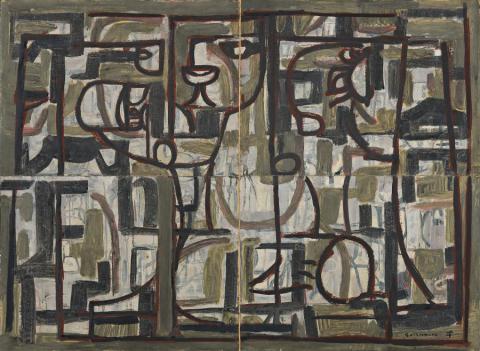GETHSEMANE, 1958
Ian Fairweather
gouache on four sheets of cardboard on hardboard
145.5 x 198.0 cm
signed with initials and inscribed lower right: Gethsemane IF
Macquarie Galleries, Sydney
Patrick White, Sydney
Collection of the Art Gallery of New South Wales, Sydney,
gift of the above, 1974 (label attached verso)
Ian Fairweather, Macquarie Galleries, Sydney, 19 November - 1 December 1958, cat. 4
Blake Prize for Religious Art, Art Gallery of New South Wales, Sydney, 1959
Contemporary Australian Art, Auckland City Art Gallery, Auckland, May 1960, cat. 21
Anderson, P., 'Ian Fairweather: a web of memory and feeling', Art and Australia, vol. 44 no. 2, December 2006 - February 2007, pp. 252–255
Bail, M., Fairweather, Murdoch Books, Sydney, revised edition 2009, pp. 143, 146, 150, 154, 194
When Ian Fairweather painted a series of grand religious subjects in 1958, the subject was not new to his art. What was different was their scale and assurance that raised them to that rare height of masterpieces. Two of them, The Last Supper and Gethsemane were included in Fairweather's solo exhibition at the Macquarie Galleries, Sydney in November - December of that year. The very impressed art critic for the Sydney Morning Herald began his review with the words, 'A new and magnificent power and scale impresses in the latest Ian Fairweather exhibition of gouache paintings...'1 Gethsemane was singled out for special comment:
'In the deeply sombre and large (7ft by 5ft) Gethsemane the generously moving rhythms of the large linear structures are placed with the quickening combination of the lighter drawn symbols of the theme, while an undercurrent of vibrating smaller shapes sharpens the mood. It is rich and darkly sonorous...'.
While there are figural references aplenty in Gethsemane, Fairweather did not pursue the narrative path, which attracted such earlier masters as Giovanni Bellini and El Greco in their depictions of Christ's agony in the garden. From Giotto onwards, others chose the dramatic moment of the betrayal by Judas. All of this took place in the Garden of Gethsemane at the foot of the Mount of Olives. Fairweather, by contrast, embraced the whole drama of Gethsemane, exploring the tensions, moods and emotions of that night. The profiled figures, angular forms, and dark colours evoke Christ's anguished prayer that He might be spared the coming Crucifixion. There is also his disappointment at the repeated discovery of the disciples asleep. Interlocking calligraphy, repeated forms, and colours darkly moving are the means Fairweather used to create this extraordinary passionate painting.
The outstanding quality of these two religious works was confirmed by their acquisition by leading Australian figures' the noted author Patrick White bought Gethsemane, and The Last Supper was originally in the collection of the renowned scholar and gallery curator, Daniel Thomas. The importance of these and earlier religious works was likewise acknowledged by Australia's public art galleries. Palm Sunday, painted in Darwin in circa 1951, is in the collection of the Queensland Art Gallery; Ave Maria 1957 is in the Art Gallery of Western Australia; Flight into Egypt 1960 is in the Tasmanian Museum and Art Gallery; Marriage at Cana 1963 in the National Gallery of Australia, Canberra; and the greatest of them all, Epiphany 1961-62 was acquired by the Queensland Art Gallery under the enlightened directorship of Laurie Thomas. The large, celebratory Alleluyah 1958, in the National Gallery of Victoria, like Gethsemane is painted on four sheets. And another religious work of 1958, Annunciation, is in the Art Gallery of New South Wales.
Patrick White bought Gethsemane in 1961. His interest in and attachment to the painting was so great that at first it hung in his bedroom at Castle Hill; then above his writing desk following a move closer to Centennial Park. As White's biographer Verity Hewitt observed, 'this sombre work in Fairweather's linear curves influenced by cubism and Chinese calligraphy would have provided a constant invitation to meditation'.2 Gethsemane along with Annunciation were selected for entry in the 1959 Blake Prize. A few years later, writing to Father Michael Scott, one of the Blake Prize's founders, White said, 'I am proud to own [Gethsemane], and hope Fairweather will get all the credit he should for having created it.'3 White's admiration for the painting later led him to seek out the reclusive Fairweather on Bribie Island. 'Fairweather lived absolutely White's dream of the artist stripped bare: at the age of seventy-three he lived and painted in an open hut in the bush'.4 In 1974 White made a magnificent gift to the Art Gallery of New South Wales, when Fairweather's Gethsemane was presented together with many works by Roy de Maistre, and Sidney Nolan.
1.'Ian Fairweather Shows His Unique Position', Sydney Morning Herald, 19 November 1958, p. 2
2. Hewitt, H. V., Patrick White, Painter, Manque: Paintings, painters and their Influences on his writings, Miegunyah Press, Melbourne, 2002, p. 47
3. Ibid., p. 54
4. Marr, D., Patrick White, A Life, Random House Australia, Canberra, 1991, p. 379
DAVID THOMAS
